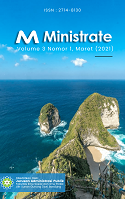Analisis Pandemi Covid-19 Dalam Presfektif Collective Action (Studi Kasus: Kecamatan Cariu Kabupaten Bogor)
DOI:
https://doi.org/10.15575/jbpd.v3i1.9401Abstract
In the midst of the Covid-19 pandemic, many people are affected by health, economic and social aspects. With the existence of a government policy regarding large-scale social restrictions to break the chain of the virus but it creates new problems in the community. Starting from the existing problems, social actions or social activities can help overcome covid-19. Collective actions taken by the community in the midst of the Covid-19 pandemic are small things that can help overcome problems in the community. Community collective action in the form of preventive, curative and promotive actions. Collective preventive action is to distribute masks, hand sanitizers, and spray disinfectants. Collective action in a curative manner, namely by providing social assistance, working on the waqf land and fish ponds, then the visiting neighbor program. Collective action in a promotive manner, namely by disseminating information related to Covid-19 to the public and also by making a handbag made by a cariu student forum from betel leaf. Collective action fosters empathic norms and attitudes in society. Collective action works best when free riding is avoided. The large number of illegal riders made the collective action not maximal. Collective action will also run well if data data and information are well available. Collective action can work well if social capital in the form of a sense of belonging, human values, and empathy grows in individuals.References
Covid-, S. M. P. (2020). Jaminan Hak Kesehatan Pekerja Work From Office. 4, 57–62.
Foys, B. (2014). The logic of collective action. In Economist (United Kingdom) (Vol. 410, Issue 8872). https://doi.org/10.4337/9781843763017.00013
Jasper, James M., 1997. The Art of Moral Protest, Culture, Biography andCreativity in Social Movement. Chicago: The University of Chicago Press
Olson, Mancur. 1965. The Logic of Collective Action: Public Goods and the Theory of Groups. Harvard: Cambridge.
Tajfel, H. & Turner, J. C. 1986. The Social Identitiy Theory of Intergroup Behavior dalam S. Warchel & W. G. Austin (Eds.). Psichology of Intergroup Relations, pp. 7-29. Nelson Hall:Chicago.
Tilly, Louise A dan Charles Tilly (eds), Class Conflict and Collection Action, Baverly Hills: Sage. 1981,
Willer, R. (2009). A status theory of collective action. Advances in Group Processes, 26(September 2009), 133–163. https://doi.org/10.1108/S0882-6145(2009)0000026009
Wright, S., Taylor, D. M., & Moghaddam F.M. 1990. Responding Membership in a Disadvantaged Group: From Acceptance to Collective Protest. Journal of Personalitiy and Social Psychology,Vol 54, No. 6, pp. 994-1003.
Downloads
Additional Files
Published
Issue
Section
License
Authors who publish with this journal agree to the following terms:
- Authors retain copyright and grant the journal right of first publication with the work simultaneously licensed under a Creative Commons Attribution-ShareAlike 4.0 International License that allows others to share the work with an acknowledgement of the work's authorship and initial publication in this journal.
- Authors are able to enter into separate, additional contractual arrangements for the non-exclusive distribution of the journal's published version of the work (e.g., post it to an institutional repository or publish it in a book), with an acknowledgement of its initial publication in this journal.
- Authors are permitted and encouraged to post their work online (e.g., in institutional repositories or on their website) prior to and during the submission process, as it can lead to productive exchanges, as well as earlier and greater citation of published work (See The Effect of Open Access).
